Moderate intensity continuous versus high intensity interval training: Metabolic responses of slow and fast skeletal muscles in rat
- PMID: 37792807
- PMCID: PMC10550171
- DOI: 10.1371/journal.pone.0292225
Moderate intensity continuous versus high intensity interval training: Metabolic responses of slow and fast skeletal muscles in rat
Abstract
The healthy benefits of regular physical exercise are mainly mediated by the stimulation of oxidative and antioxidant capacities in skeletal muscle. Our understanding of the cellular and molecular responses involved in these processes remain often uncomplete particularly regarding muscle typology. The main aim of the present study was to compare the effects of two types of exercise training protocol: a moderate-intensity continuous training (MICT) and a high-intensity interval training (HIIT) on metabolic processes in two muscles with different typologies: soleus and extensor digitorum longus (EDL). Training effects in male Wistar rats were studied from whole organism level (maximal aerobic speed, morphometric and systemic parameters) to muscle level (transcripts, protein contents and enzymatic activities involved in antioxidant defences, aerobic and anaerobic metabolisms). Wistar rats were randomly divided into three groups: untrained (UNTR), n = 7; MICT, n = 8; and HIIT, n = 8. Rats of the MICT and HIIT groups ran five times a week for six weeks at moderate and high intensity, respectively. HIIT improved more than MICT the endurance performance (a trend to increased maximal aerobic speed, p = 0.07) and oxidative capacities in both muscles, as determined through protein and transcript assays (AMPK-PGC-1α signalling pathway, antioxidant defences, mitochondrial functioning and dynamics). Whatever the training protocol, the genes involved in these processes were largely more significantly upregulated in soleus (slow-twitch fibres) than in EDL (fast-twitch fibres). Solely on the basis of the transcript changes, we conclude that the training protocols tested here lead to specific muscular responses.
Copyright: © 2023 Pengam et al. This is an open access article distributed under the terms of the Creative Commons Attribution License, which permits unrestricted use, distribution, and reproduction in any medium, provided the original author and source are credited.
Conflict of interest statement
The authors have declared that no competing interests exist.
Figures
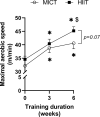

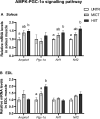
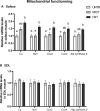
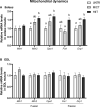
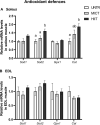
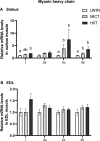
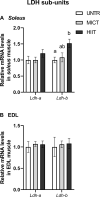
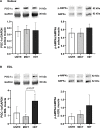
Similar articles
-
Metabolic cross-talk between skeletal muscle and adipose tissue in high-intensity interval training vs. moderate-intensity continuous training by regulation of PGC-1α.Eat Weight Disord. 2020 Feb;25(1):17-24. doi: 10.1007/s40519-018-0491-4. Epub 2018 Feb 26. Eat Weight Disord. 2020. PMID: 29480414
-
High-intensity interval training changes the expression of muscle RING-finger protein-1 and muscle atrophy F-box proteins and proteins involved in the mechanistic target of rapamycin pathway and autophagy in rat skeletal muscle.Exp Physiol. 2019 Oct;104(10):1505-1517. doi: 10.1113/EP087601. Epub 2019 Aug 29. Exp Physiol. 2019. PMID: 31357248
-
The effects of different exercise training protocols on mitochondrial dynamics in skeletal and cardiac muscles of Wistar rats.J Orthop Surg Res. 2025 Apr 19;20(1):395. doi: 10.1186/s13018-025-05809-w. J Orthop Surg Res. 2025. PMID: 40251584 Free PMC article.
-
Physiological adaptations to interval training and the role of exercise intensity.J Physiol. 2017 May 1;595(9):2915-2930. doi: 10.1113/JP273196. Epub 2016 Dec 7. J Physiol. 2017. PMID: 27748956 Free PMC article. Review.
-
The effect of high Intensity interval training versus moderate intensity continuous training on arterial stiffness and 24h blood pressure responses: A systematic review and meta-analysis.J Sci Med Sport. 2019 Apr;22(4):385-391. doi: 10.1016/j.jsams.2018.09.228. Epub 2018 Sep 22. J Sci Med Sport. 2019. PMID: 30803498
Cited by
-
Mitochondrial remodelling supports migration in white-crowned sparrows (Zonotrichia leucophrys).Proc Biol Sci. 2024 Dec;291(2036):20242409. doi: 10.1098/rspb.2024.2409. Epub 2024 Dec 11. Proc Biol Sci. 2024. PMID: 39657813
-
Combined Effects of Spirulina Liquid Extract and Endurance Training on Aerobic Performance and Muscle Metabolism Adaptation in Wistar Rats.Nutrients. 2025 Jan 14;17(2):283. doi: 10.3390/nu17020283. Nutrients. 2025. PMID: 39861413 Free PMC article.
-
Ageing, Cognitive Decline, and Effects of Physical Exercise: Complexities, and Considerations from Animal Models.Brain Plast. 2024 May 14;9(1-2):43-73. doi: 10.3233/BPL-230157. eCollection 2024. Brain Plast. 2024. PMID: 38993577 Free PMC article. Review.
-
Effects of high-intensity interval training and moderate-intensity continuous training on mitochondrial dynamics in human skeletal muscle.Front Physiol. 2025 Apr 17;16:1554222. doi: 10.3389/fphys.2025.1554222. eCollection 2025. Front Physiol. 2025. PMID: 40313872 Free PMC article.
-
Novel insights into athlete physical recovery concerning lactate metabolism, lactate clearance and fatigue monitoring: A comprehensive review.Front Physiol. 2025 Mar 25;16:1459717. doi: 10.3389/fphys.2025.1459717. eCollection 2025. Front Physiol. 2025. PMID: 40200988 Free PMC article. Review.
References
Publication types
MeSH terms
Substances
Associated data
LinkOut - more resources
Full Text Sources
Miscellaneous

